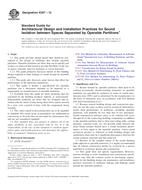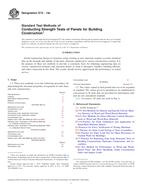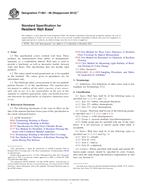Wir benötigen Ihre Einwilligung zur Verwendung der einzelnen Daten, damit Sie unter anderem Informationen zu Ihren Interessen einsehen können. Klicken Sie auf "OK", um Ihre Zustimmung zu erteilen.
ASTM E2128-12
Standard Guide for Evaluating Water Leakage of Building Walls
Automatische name übersetzung:
Standard-Leitfaden zur Bewertung von Wasseraustritt von Gebäudewänden
NORM herausgegeben am 1.1.2012
Informationen über die Norm:
Bezeichnung normen: ASTM E2128-12
Anmerkung: UNGÜLTIG
Ausgabedatum normen: 1.1.2012
SKU: NS-44405
Zahl der Seiten: 36
Gewicht ca.: 108 g (0.24 Pfund)
Land: Amerikanische technische Norm
Kategorie: Technische Normen ASTM
Kategorie - ähnliche Normen:
Die Annotation des Normtextes ASTM E2128-12 :
Keywords:
evaluation, inspection, testing, water leakage, Water leakage, Building materials/applications, Drainage materials/systems, Evaluation--building components/applications, Exterior walls, Inspection--buildings, Retention characteristics/testing, Walls, ICS Number Code 91.060.10 (Walls. Partitions. Facades)
Ergänzende Informationen
| Significance and Use | ||||||||||||||||||
|
This guide is intended to provide building professionals with a comprehensive methodology for evaluating water leakage through walls. It addresses the performance expectations and service history of a wall, the various components of a wall, and the interaction between these components and adjacent construction. It is not intended as a construction quality control procedure, nor as a preconstruction qualification procedure. It is intended for evaluating buildings that exhibit water leakage. Qualifications—This guide requires the evaluator to possess a knowledge of basic physics and of construction and wall design principles and practices. Application—The sequential activities described herein are intended to produce a complete and comprehensive evaluation program, but all activities may not be applicable or necessary for a particular evaluation program. It is the responsibility of the professional using this guide to determine the activities and sequence necessary to properly perform an appropriate leakage evaluation for a specific building. Preliminary Assessment—A preliminary assessment may indicate that water leakage problems are limited to a specific element or portion of a wall. The preliminary assessment may also indicate that the wall is not the source of a leak even though it is perceived as such by the building occupant. The presence of water might result from a roofing problem, a condensation problem, a plumbing problem, operable windows or doors left opened or unlatched or some other condition not directly related to water leakage through the building wall and is outside the scope of this guide. The evaluation of causes may likewise be limited in scope, and the procedures recommended herein abridged according to the professional judgement of the evaluator. A statement stipulating the limits of the investigation should be included in the report. Expectations—Expectations about the overall effectiveness of an evaluation program must be reasonable and in proportion to a defined scope of work and the effort and resources applied to the task. The objective is to be as comprehensive as possible within a defined scope of work. The methodology in this guide is intended to address intrinsic leakage behavior properties of a wall system, leading to conclusions that generally apply to similar locations on the building. Since every possible location is not included in an evaluation program, it is probable that every leak source will not be identified. Leakage sources that are localized and unique may remain and may require additional localized evaluation effort. The potential results and benefits of the evaluation program should not be over-represented. This guide is not intended as a design guide or as a guide specification. Reference is made to design features of a wall only for the purpose of identifying items of interest for consideration in the evaluation process. This guide does not address leakage through roofs, leakage below grade, or water that accumulates due to water vapor migration and condensation. It is not intended for use with structures designed to retain water, such as pools and fountains. |
||||||||||||||||||
| 1. Scope | ||||||||||||||||||
|
1.1 This guide describes methods for determining and evaluating causes of water leakage of exterior walls. For this purpose, water penetration is considered leakage, and therefore problematic, if it exceeds the planned resistance or temporary retention and drainage capacity of the wall, is causing or is likely to cause premature deterioration of a building or its contents, or is adversely affecting the performance of other components. A wall is considered a system including its exterior and interior finishes, fenestration, structural components, and components for maintaining the building interior environment. 1.2 Investigative techniques discussed may be intrusive, disruptive, or destructive. It is the responsibility of the investigator to establish the limitations of use, to anticipate and advise of the destructive nature of some procedures, and to plan for patching and selective reconstruction as necessary. 1.3 This practice does not purport to address all of the safety concerns, if any, associated with its use. Establish appropriate safety and health practices and determine the applicability of regulatory limitations prior to use. Awareness of safety and familiarity with safe procedures are particularly important for above-ground operations on the exterior of a building and destructive investigative procedures which typically are associated with the work described in this guide. |
||||||||||||||||||
| 2. Referenced Documents | ||||||||||||||||||
|
Ähnliche Normen:
Historisch
1.6.2010
Historisch
1.2.2009
Historisch
1.4.2012
Historisch
1.7.2014
Historisch
1.11.2012
Historisch
15.11.2012
Empfehlungen:
Aktualisierung der technischen Normen
Wollen Sie sich sicher sein, dass Sie nur die gültigen technischen Normen verwenden?
Wir bieten Ihnen eine Lösung, die Ihnen eine Monatsübersicht über die Aktualität der von Ihnen angewandten Normen sicher stellt.
Brauchen Sie mehr Informationen? Sehen Sie sich diese Seite an.



 ASTM E519/E519M-10..
ASTM E519/E519M-10.. ASTM E547-00(2009)..
ASTM E547-00(2009).. ASTM E557-12
ASTM E557-12 ASTM E72-14a
ASTM E72-14a ASTM E864-12
ASTM E864-12 ASTM F1861-08(2012)e..
ASTM F1861-08(2012)e..
 Cookies
Cookies
